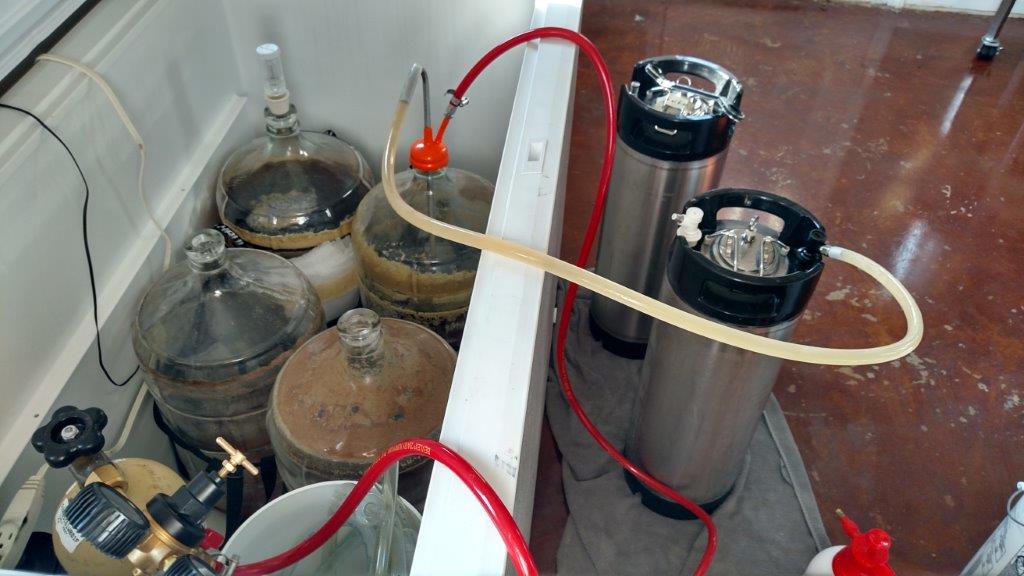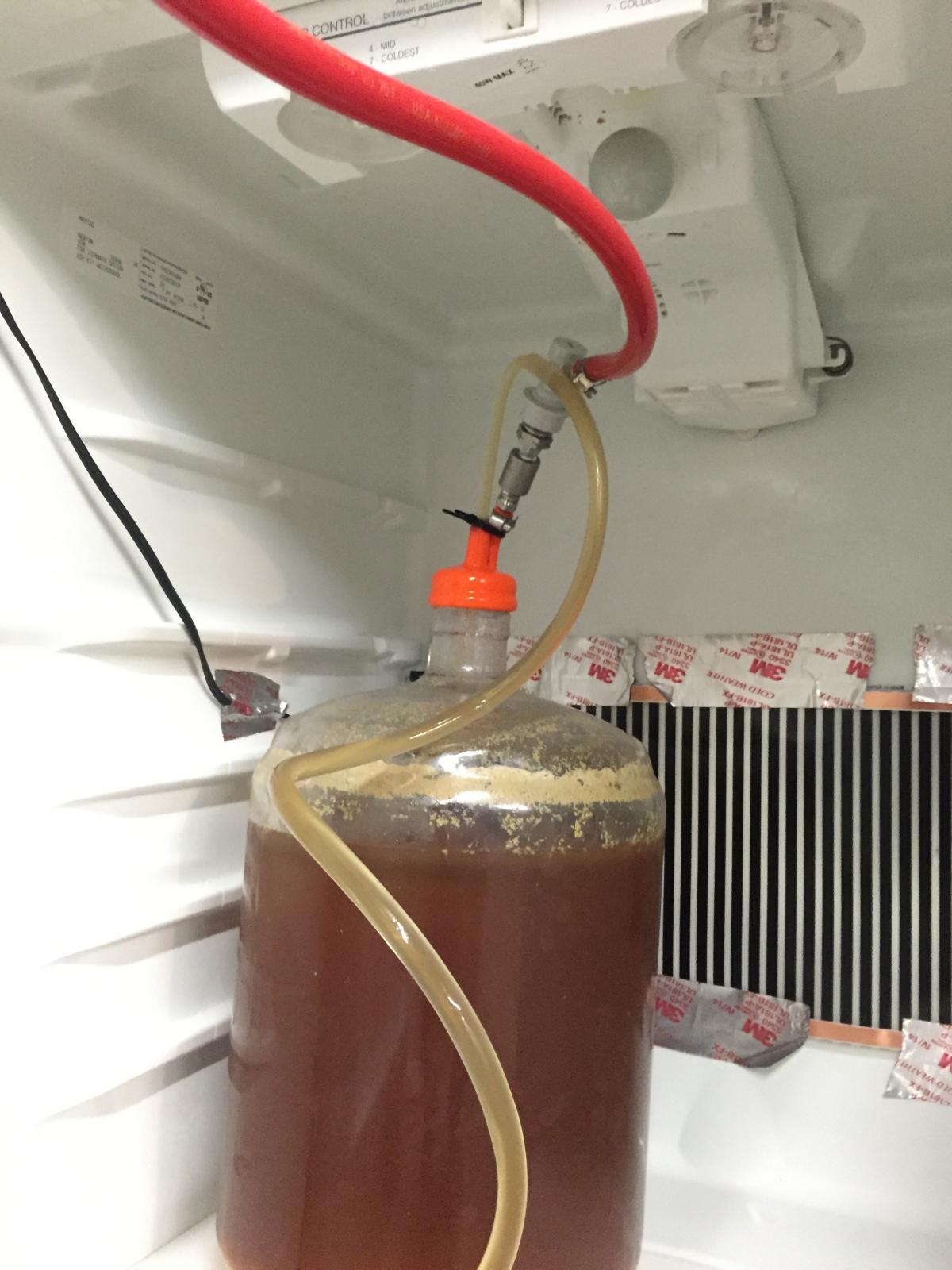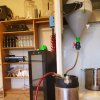Has anyone done a closed system transfer using co2 with a pet carboy? Can they handle the 1 to 2 psi of co2 used to push the beer. I would think the rubber carboy blowout hood would pop off before the plastic cracked.
You are using an out of date browser. It may not display this or other websites correctly.
You should upgrade or use an alternative browser.
You should upgrade or use an alternative browser.
Closed system transfer with pet carboy
- Thread starter h22lude
- Start date

Help Support Homebrew Talk:
This site may earn a commission from merchant affiliate
links, including eBay, Amazon, and others.
I have and it's just fine but you have to be really easy on the PSI. Mine is "mostly" gravity. I started it with the Universal Carboy Cap at about 2 psi JUST till the siphon started then backed off a little. The PET did swell even at that little PSI.
Cheers
Jay
Cheers
Jay
h22lude
Well-Known Member
Good to know, thanks. My plan is to turn my reg all the way down and slowly turn it until I get the slowest flow possible. I'll probably put the carboy on my keezer so gravity can help too.
I tried this with my bucket. The lid was swelling and it sounding like co2 was leaking out. Couldn't tell if it was from the lid seal or from around the racking cane.
I tried this with my bucket. The lid was swelling and it sounding like co2 was leaking out. Couldn't tell if it was from the lid seal or from around the racking cane.
Are you going to be using a 3/8 or 1/2" tubing? Mine was 3/8" When I was doing it. Yeah the PET carboy was popping making all kinds of noises. But it worked. I don't do it like that anymore I just fill my keg with CO2 and rack from the bucket or carboy. I don't feel like I get any air in there. It is a little easier to just use my Auto Siphon....
Good luck.
Cheers
Jay
Good luck.
Cheers
Jay
h22lude
Well-Known Member
I have 3/8" tubing and stainless racking cane. I think once I get the siphon going, I'll cut back on the co2. I'm using an auto siphon now. It works great but I want to try to eliminate as much o2 exposure as possible. Whether it helps or not is another thing. I do want to replace my buckets so this is as good of a time as any to try something new. I could try using my auto siphon connected to the beer in. That should eliminate most of the o2 exposure.
Did you find using co2 made the transfer faster?
Did you find using co2 made the transfer faster?
I used to do this with glass carboys. It worked fine, the cap would blow off around 2psi or so. I used one of these http://www.amazon.com/dp/B00KTS20JM/?tag=skimlinks_replacement-20 to knock my pressure down (and now use it for positive pressure cold crashing in conicals).


Last edited by a moderator:
![Craft A Brew - Safale S-04 Dry Yeast - Fermentis - English Ale Dry Yeast - For English and American Ales and Hard Apple Ciders - Ingredients for Home Brewing - Beer Making Supplies - [1 Pack]](https://m.media-amazon.com/images/I/41fVGNh6JfL._SL500_.jpg)
$6.95 ($17.38 / Ounce)
$7.47 ($18.68 / Ounce)
Craft A Brew - Safale S-04 Dry Yeast - Fermentis - English Ale Dry Yeast - For English and American Ales and Hard Apple Ciders - Ingredients for Home Brewing - Beer Making Supplies - [1 Pack]
Hobby Homebrew

$39.22 ($39.22 / Count)
Brewer's Best Home Brew Beer Ingredient Kit - 5 Gallon (Mexican Cerveza)
Amazon.com

$10.99 ($31.16 / Ounce)
Hornindal Kveik Yeast for Homebrewing - Mead, Cider, Wine, Beer - 10g Packet - Saccharomyces Cerevisiae - Sold by Shadowhive.com
Shadowhive

$7.79 ($7.79 / Count)
Craft A Brew - LalBrew Voss™ - Kveik Ale Yeast - For Craft Lagers - Ingredients for Home Brewing - Beer Making Supplies - (1 Pack)
Craft a Brew

$53.24
1pc Hose Barb/MFL 1.5" Tri Clamp to Ball Lock Post Liquid Gas Homebrew Kegging Fermentation Parts Brewer Hardware SUS304(Liquid Hose Barb)
yunchengshiyanhuqucuichendianzishangwuyouxiangongsi

$22.00 ($623.23 / Ounce)
AMZLMPKNTW Ball Lock Sample Faucet 30cm Reinforced Silicone Hose Secondary Fermentation Homebrew Kegging joyful
无为中南商贸有限公司

$58.16
HUIZHUGS Brewing Equipment Keg Ball Lock Faucet 30cm Reinforced Silicone Hose Secondary Fermentation Homebrew Kegging Brewing Equipment
xiangshuizhenzhanglingfengshop

$172.35
2 Inch Tri Clamp Keg Manifold With Ball Lock Posts, Pressure Gauge, PRV (0-30 PSI) – Homebrew, Fermentation, Kegging System
wuhanshijiayangzhiyimaoyiyouxiangongsi

$176.97
1pc Commercial Keg Manifold 2" Tri Clamp,Ball Lock Tapping Head,Pressure Gauge/Adjustable PRV for Kegging,Fermentation Control
hanhanbaihuoxiaoshoudian

$27.29 ($13.64 / Count)
$41.99 ($21.00 / Count)
2 Pack 1 Gallon Large Fermentation Jars with 3 Airlocks and 2 SCREW Lids(100% Airtight Heavy Duty Lid w Silicone) - Wide Mouth Glass Jars w Scale Mark - Pickle Jars for Sauerkraut, Sourdough Starter
Qianfenie Direct

$53.24
1pc Hose Barb/MFL 1.5" Tri Clamp to Ball Lock Post Liquid Gas Homebrew Kegging Fermentation Parts Brewer Hardware SUS304(Liquid Hose Barb)
Guangshui Weilu You Trading Co., Ltd

$33.95
Five Star - 6022b_ - Star San - 32 Ounce - High Foaming Sanitizer
Bridgeview Beer and Wine Supply
h22lude
Well-Known Member
I do it all the time. You have to start the transfer at about 2psi then back down to maybe .75-1psi.
Takes about 10-15 minutes. If you go higher on the psi it'll blow the orange cap off in a big boom of CO2.
Is that pet or glass? What kind of connections do you have for that gas line to hook up the disconnect to?
Is that pet or glass? What kind of connections do you have for that gas line to hook up the disconnect to?
It's PET.
I have a gas in post with a 9/18 to 1/4" mpt fitting, then a 1/4" female to female coupler, and then a 1/4"mpt to barb that I clamped to the orange cap.
GotPushrods
Well-Known Member
I would think the rubber carboy blowout hood would pop off before the plastic cracked.
That's exactly what will happen. (I use the standard orange caps) I keep my hand on the cap and pop the regulator up for just a second to start the transfer, then back it off. There's always a small hiss from the edges of the cap and the regulator never gets past 1 psi.
The carboy is definitely more firm, but I'm not worried about cracking it open. If I do every crack one open, I think it will still be worth all the success I've had before.
I always have quite a few kegs in rotation and they can sit around for quite a while. I've had to rethink my methods and now can have a 1-year+ beer on tap that's changed VERY little from the 2 or 3 month mark. I also fill kegs 100% full with StarSan and push it out with CO2 before racking. The combination results in extremely low DO beer.
h22lude
Well-Known Member
It's PET.
I have a gas in post with a 9/18 to 1/4" mpt fitting, then a 1/4" female to female coupler, and then a 1/4"mpt to barb that I clamped to the orange cap.
Sounds easy enough. Thanks. This is the route I'll most likely go.
Add a valve and use gravity and CO2. Works great.
This is my conical but works the same when using my bigmouth with the spout I added.
View attachment 353959
Don't you get a lot of yeast in the keg or do you open the valve before putting on the disconnect?
That's exactly what will happen. (I use the standard orange caps) I keep my hand on the cap and pop the regulator up for just a second to start the transfer, then back it off. There's always a small hiss from the edges of the cap and the regulator never gets past 1 psi.
The carboy is definitely more firm, but I'm not worried about cracking it open. If I do every crack one open, I think it will still be worth all the success I've had before.
I always have quite a few kegs in rotation and they can sit around for quite a while. I've had to rethink my methods and now can have a 1-year+ beer on tap that's changed VERY little from the 2 or 3 month mark. I also fill kegs 100% full with StarSan and push it out with CO2 before racking. The combination results in extremely low DO beer.
I did the same with my bucket transfer I tried. I put in 5 gallons of starsan and pushed it out with co2. There was a little empty headroom but I figured there was so little o2 in there that it wouldn't make a big difference.
AkBrew907
Well-Known Member
- Joined
- Jan 27, 2015
- Messages
- 621
- Reaction score
- 196
With the conical I dump all the nasty before attaching the hose to transfer to the keg. With the big mouth the yeast cake is below the height I have my spigot.Sounds easy enough. Thanks. This is the route I'll most likely go.
Don't you get a lot of yeast in the keg or do you open the valve before putting on the disconnect?
I did the same with my bucket transfer I tried. I put in 5 gallons of starsan and pushed it out with co2. There was a little empty headroom but I figured there was so little o2 in there that it wouldn't make a big difference.
Sounds easy enough. Thanks. This is the route I'll most likely go.
For a cheaper but slightly less easy to use option.
MFL fitting on the CO2 line http://www.homebrewing.org/14-Swivel-Flare-Nut-x-38-Barb_p_107.html
MFL fitting in the cap http://www.homebrewing.org/SS-14-MFL-x-14-barb_p_3607.html
h22lude
Well-Known Member
For a cheaper but slightly less easy to use option.
MFL fitting on the CO2 line http://www.homebrewing.org/14-Swivel-Flare-Nut-x-38-Barb_p_107.html
MFL fitting in the cap http://www.homebrewing.org/SS-14-MFL-x-14-barb_p_3607.html
Oh yeah, not a bad option either
Watch out for clogged poppets. I do closed transfers, too. I had a clogged poppet on my last transfer. On my next transfer, I'm going to take the guts out of the ball lock QD and the liquid post on the keg. That should prevent clogging. There will be a little bit of O2 exposure when adding the poppet back into the keg post, but not too much.
When I rack off a fermentor with my CO2-push rig I sanitize a square of nylon paint strainer material, a large SS washer, and a rubber band, and then attach those to the end of the SS racking tube.

The mesh is a highly effective hop fragment strainer, and the washer keeps the bag from collapsing around the tube.
I chock the carboy with a pretty good tilt and position the end of the dip tube just above the trub line towards the down-hill side. The receiver (keg or another carboy) is well below, so once the CO2 gets the beer moving I can turn the pressure down so it registers below 1 psi on the gauge and let gravity do most of the work.
The lower and thus slower you can tolerate, the less CO2 consumed...
Cheers!

The mesh is a highly effective hop fragment strainer, and the washer keeps the bag from collapsing around the tube.
I chock the carboy with a pretty good tilt and position the end of the dip tube just above the trub line towards the down-hill side. The receiver (keg or another carboy) is well below, so once the CO2 gets the beer moving I can turn the pressure down so it registers below 1 psi on the gauge and let gravity do most of the work.
The lower and thus slower you can tolerate, the less CO2 consumed...
Cheers!
h22lude
Well-Known Member
When I rack off a fermentor with my CO2-push rig I sanitize a square of nylon paint strainer material, a large SS washer, and a rubber band, and then attach those to the end of the SS racking tube.
View attachment 354254
The mesh is a highly effective hop fragment strainer, and the washer keeps the bag from collapsing around the tube.
I chock the carboy with a pretty good tilt and position the end of the dip tube just above the trub line towards the down-hill side. The receiver (keg or another carboy) is well below, so once the CO2 gets the beer moving I can turn the pressure down so it registers below 1 psi on the gauge and let gravity do most of the work.
The lower and thus slower you can tolerate, the less CO2 consumed...
Cheers!
That is a good cheap idea. I did find this which looks like it could work well.
https://www.morebeer.com/products/racking-cane-filter.html?site_id=9
What connections are you using for your gas in side?
Look closer and you'll see a ball lock gas post in that picture.
That ss mesh is a lot coarser than the paint strainer bag I cut my "screens" from.
It'd probably work for cones but it's not going to be very good for pellet mush...
Cheers!
That ss mesh is a lot coarser than the paint strainer bag I cut my "screens" from.
It'd probably work for cones but it's not going to be very good for pellet mush...
Cheers!
h22lude
Well-Known Member
Look closer and you'll see a ball lock gas post in that picture.
That ss mesh is a lot coarser than the paint strainer bag I cut my "screens" from.
It'd probably work for cones but it's not going to be very good for pellet mush...
Cheers!
Yes I do see that lol I was talking about what looks like 2 other connections.
The picture may be misleading as it includes all of the bits I use to transfer from carboy to keg - and for carboy to carboy.
That second SS tube is used at the receiving carboy, and only needs a beer line slipped over the tube. The other carboy cap port is left unconnected as the vent in that scenario.
So there's only one gas connection - to the post used at the "push" end...
Cheers!
That second SS tube is used at the receiving carboy, and only needs a beer line slipped over the tube. The other carboy cap port is left unconnected as the vent in that scenario.
So there's only one gas connection - to the post used at the "push" end...
Cheers!
h22lude
Well-Known Member
So there's only one gas connection - to the post used at the "push" end...
Cheers!
Yeah that is the connection I'm talking about. What parts did you use to connect the air post to the purple carboy blowoff hood(as morebeer calls it)?
PlinyTheMiddleAged
Well-Known Member
- Joined
- Jan 9, 2014
- Messages
- 377
- Reaction score
- 106
This is what I use:
Barb to MFL - http://www.chicompany.net/index.php?main_page=product_info&cPath=19_220_285&products_id=480
Keg post adapter - http://www.chicompany.net/index.php?main_page=product_info&cPath=376_1_3_260&products_id=1145
Keg post - http://www.chicompany.net/index.php?main_page=product_info&cPath=376_1_3_260&products_id=1137
Hope that helps!
Barb to MFL - http://www.chicompany.net/index.php?main_page=product_info&cPath=19_220_285&products_id=480
Keg post adapter - http://www.chicompany.net/index.php?main_page=product_info&cPath=376_1_3_260&products_id=1145
Keg post - http://www.chicompany.net/index.php?main_page=product_info&cPath=376_1_3_260&products_id=1137
Hope that helps!
^Exactly what I use^ - but don't forget the nylon flare washer between the MFL-barb and the post adapter...
Cheers!
Cheers!
Similar threads
- Replies
- 18
- Views
- 1K
- Replies
- 0
- Views
- 907
- Replies
- 3
- Views
- 860





































